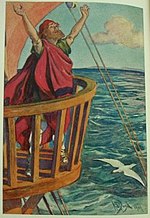Our website is made possible by displaying online advertisements to our visitors.
Please consider supporting us by disabling your ad blocker.
Madoc

Madoc ab Owain Gwynedd (also spelled Madog) was, according to folklore, a Welsh prince who sailed to the Americas in 1170, over 300 years before Christopher Columbus's voyage in 1492.
According to the story, Madoc was a son of Owain Gwynedd who went to sea to flee internecine violence at home. The "Madoc story" evolved from a medieval tradition about a Welsh hero's sea voyage, to which only allusions survive. The story reached its greatest prominence during the Elizabethan era when English and Welsh writers wrote of the claim Madoc had gone to the Americas as an assertion of prior discovery, and hence legal possession, of North America by the Kingdom of England.[1][2]
The Madoc story remained popular in later centuries, and a later development said Madoc's voyagers had intermarried with local Native Americans, and that their Welsh-speaking descendants still live in the United States. These "Welsh Indians" were credited with the construction of landmarks in the Midwestern United States, and a number of white travellers were inspired to search for them. The Madoc story has been the subject of much fantasy in the context of pre-Columbian trans-oceanic contact theories. No archaeological, linguistic, or other evidence of Madoc or his voyages has been found in the New or Old World but legends connect him with certain sites, such as Devil's Backbone on the Ohio River near Louisville, Kentucky.[3]
- ^ Fowler 2010, p. 54.
- ^ Owen & Wilkins 2006, p. 546.
- ^ Curran 2008.
Previous Page Next Page


